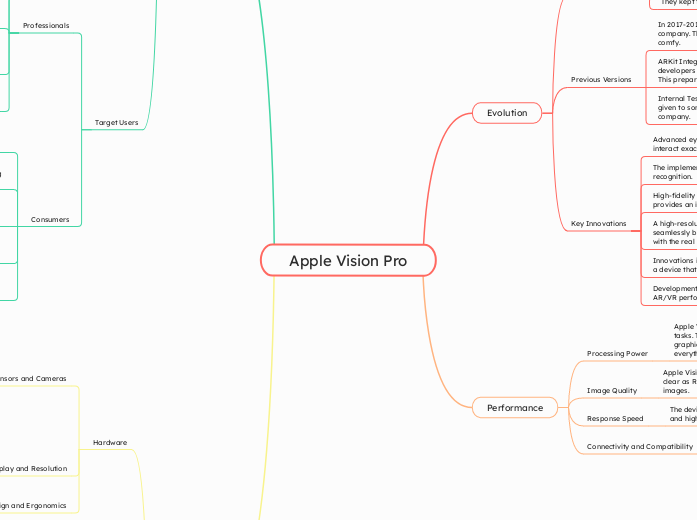Apple Vision Pro
Evolution
Development Start
Apple Vision Pro started being made seriously around 2015.
Apple bought some AR/VR companies and tech. They kept the project a big secret.
Previous Versions
In 2017-2018, Apple tested early models inside the company. They wanted to make them light and comfy.
ARKit Integration (2017): With iOS 11, ARKit let developers make AR apps for iPhones and iPads. This prepared for better hardware.
Internal Testing Units (2019-2020): These units were given to some developers and testers inside the company.
Key Innovations
Advanced eye-tracking lets you control and interact exactly in the AR/VR world.
The implementation of sophisticated gesture recognition.
High-fidelity spatial audio technology that provides an immersive audio experience.
A high-resolution display system capable of seamlessly blending augmented reality elements with the real world.
Innovations in materials and ergonomics to create a device that is comfortable for extended use.
Development of custom silicon chips optimized for AR/VR performance.
Performance
Processing Power
Apple Vision Pro has special chips for AR/VR tasks. These powerful chips show detailed graphics, handle real-time sensor data, and keep everything running smoothly without delays.
Image Quality
Apple Vision Pro has high-resolution screens, as clear as Retina displays, giving sharp, colorful images.
Response Speed
The device works fast with low-latency processing and high refresh rates, likely over 90Hz.
Connectivity and Compatibility
Apple Vision Pro connects wirelessly with Wi-Fi 6 or better and Bluetooth for other devices.
Usage
Application Areas
Augmented Reality (AR)
Providing turn-by-turn directions overlaid on the real world.
Visualizing furniture and decor in a real room.
Allowing customers to see how products will look and fit before purchasing.
Displaying contextual information about objects and landmarks.
Virtual Reality (VR)
Exploring virtual recreations of real-world locations, such as museums or historical sites.
Training simulations for professionals, such as flight simulators for pilots.
Providing immersive gaming experiences where users can interact with a fully virtual world.
Education and Training
Creating immersive educational environments where students can interact with 3D models and virtual objects.
Simulating real-life scenarios for vocational training.
Offering virtual field trips to places that are otherwise inaccessible.
Entertainment and Gaming
Immersive Games
Interactive Storytelling
Social Experiences
Health and Medicine
Surgical Training
Therapy and Rehabilitation
Medical Visualization
Patient Education:
Target Users
Professionals
Allows engineers and designers to visualize and manipulate 3D models in real-time, enhancing the design process and enabling more accurate prototyping.
Surgeons and medical professionals can use the device for virtual training and planning complex surgeries with 3D models of patient anatomy.
Architects can create and showcase virtual models of buildings, while construction professionals can use AR overlays to visualize structures on-site.
Facilitates virtual meetings and collaborative workspaces where team members can interact with digital content and each other in a shared virtual environment.
Educators can create immersive learning experiences, and corporate trainers can develop realistic simulations for employee training.
Consumers
Provides an immersive gaming experience, allowing users to interact with virtual worlds and characters in ways that were not possible before.
Enables users to watch movies and videos in a virtual theater setting, providing a more engaging and cinematic experience.
Allows for virtual meetups and socializing in shared virtual spaces, enhancing connections with friends and family.
Helps users visualize home improvement projects by overlaying virtual furniture, decor, and architectural changes onto their real-world space.
Offers guided virtual workouts and wellness activities, creating interactive and motivating fitness experiences at home.
Features
Hardware
Sensors and Cameras
Depth Sensors for spatial awareness and accurate environment mapping.
High-resolution cameras for capturing the real world and enabling AR applications.
Combines accelerometers and gyroscopes for precise motion tracking.
Adjusts display brightness and contrast according to surrounding light conditions.
Display and Resolution
The screens have high pixel density for clear images and to avoid the screen-door effect. The resolution is good for both close-up VR and distant AR overlays, giving a great visual experience.
Design and Ergonomics
The device is made to be comfortable, with lightweight materials and a shape that spreads the weight evenly.
Software
Operating System
Apple Vision Pro runs on a special version of iOS, probably called "visionOS," made for AR/VR apps. This OS works well with other Apple devices and services, giving a familiar and easy user experience.
Built-in Applications
AR/VR Games
Productivity Tools
Educational Apps
User Interface
The user interacts with the device using gestures, voice commands, and eye-tracking. The interface is easy to use, thanks to Apple's user experience design. Virtual menus appear in your view, so you can interact without physical controllers.
Technological Innovations
Gesture Control
Advanced gesture recognition lets you interact with digital objects and navigate menus with hand and finger movements.
Voice Recognition
Voice recognition lets you control the device without using your hands.
Eye Tracking
Eye-tracking tech watches where you look, letting you control and interact in AR/VR exactly.
